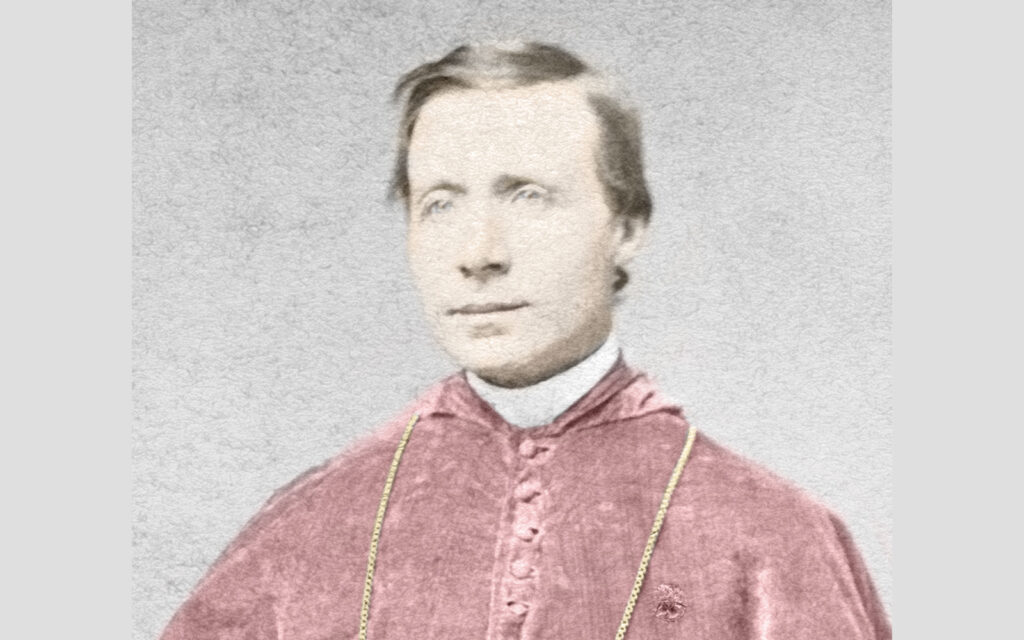BISHOP JAMES GIBBONS
A BESTSELLER WRITTEN IN RICHMOND
A room off the vestibule of the Pro-Cathedral of St. Peter — the first cathedral of the Diocese of Richmond — contains an imposing oak desk that belonged to James Gibbons, the fourth bishop of Richmond (1872–1877).
It was likely on that desk that Bishop Gibbons wrote “Faith of Our Fathers,” a best-selling explanation of the Catholic faith published in December 1876. The work earned Gibbons national acclaim and helped him become one of the best-known and most influential churchmen of his time.
Gibbons (1834–1921) was born to Irish immigrants in Baltimore. When he was about 5 years old, his father contracted tuberculosis and moved the family to Ireland in the hopes of recovering (1839). After his father died (1847), his mother settled the family in New Orleans (1853).
Gibbons studied for the priesthood at St. Charles College in Ellicott City, Maryland (1855–1857), and then at St. Mary’s Seminary in Baltimore (1857–1861). He was ordained a priest for the Archdiocese of Baltimore in 1861. Father Gibbons served in two parishes and was a volunteer chaplain at Fort McHenry and Fort Marshall in Baltimore during the Civil War (1861–1865). In 1865, he became secretary to Archbishop Martin Spalding of Baltimore and was tasked with making the preparations for the Second Plenary Council of Baltimore (1866).
The council brought together bishops from across the United States in the aftermath of the Civil War to express and strengthen the unity of the Catholic Church. Among other things, the Second Plenary Council urged bishops to evangelize freed slaves and recommended the establishment of new dioceses, including one for North Carolina. This local Church was to be a vicariate apostolic (missionary diocese), and the council, at the urging of Archbishop Spalding, recommended Gibbons to be its first bishop.
In 1868, Gibbons was ordained a bishop. Just 34 years old, he was called “The Boy Bishop.” Gibbons served as vicar apostolic of North Carolina (1868–1878), governing an expansive territory with few Catholics. He participated in Vatican Council I (1869–1870) — the youngest of 700 bishops in attendance. Vatican I is remembered for having taught that, under certain conditions, the pope could teach infallibly on matters of faith and morals.
Following the death in 1872 of John McGill, the third bishop of Richmond (1850–1872), Gibbons was appointed his successor, while remaining vicar apostolic of North Carolina.
Gibbons spent five years in Richmond (1872–1877). During this time, he initiated the diocese’s outreach to African Americans, although these efforts had limited success. The diocese as a whole grew modestly during his tenure: from 17 to 25 priests, from 15 to 22 churches, from 15 to 24 chapels, and from 14 to 24 schools. The Catholic population remained about 17,000 — 7% of the population.
Gibbons was appointed coadjutor of the Archdiocese of Baltimore in 1877, meaning that he would automatically become its archbishop when the incumbent archbishop died. Soon after he was notified of his appointment, his predecessor died, and Gibbons assumed leadership of the archdiocese.
In Baltimore (1877–1921), Gibbons was made the second cardinal (1886) of the United States and became a national figure. Throughout his life, he strove to demonstrate one could be a devout Catholic and a patriotic American — a proposition that was sometimes questioned at that time by Catholic authorities in Rome and by non-Catholics in the United States.
Gibbons helped advance his position by writing the above-mentioned book, whose full title was “The Faith of Our Fathers: Being a Plain Exposition and Vindication of the Church Founded by Our Lord Jesus Christ.” As he explained in the preface, an excerpt of which appears below, Gibbons sought to explain and defend the Catholic faith.
His book was different from other Catholic apologetic works of the time because it was written in a non-polemical way. This tone surely reflected the historical experience of Catholics in Virginia and in North Carolina — and Gibbons’ experience in those places — as a religious minority striving for social acceptance.
Father John Banister Tabb, a priest of the Richmond Diocese and a poet whom Gibbons had earlier received into the Catholic Church (1872), made stylistic contributions to the work. By the time of Gibbons’ death, “Faith of Our Fathers” had gone through 93 editions and had been translated into several languages. The book remains in circulation today.
Preface.
The object of this little volume is to present in a plain and practical form an exposition and vindication of the principal tenets of the Catholic Church. It was thought sufficient to devote but a brief space to such Catholic doctrines and practices as are happily admitted by Protestants, while those that are controverted by them are more elaborately elucidated.
The work was compiled by the author during the uncertain hours which he could spare from the more active duties of the ministry. It substantially embodies the instructions and discourses delivered by him before mixed congregations in Virginia and North Carolina. …
As his chief aim has been to bring home the truths of the Catholic faith to our separated brethren, who generally accept the Scripture as the only source of authority in religious matters, he has endeavored to fortify his statements by abundant reference to the sacred text. He has thought proper, however, to add frequent quotations from the early Fathers [of the Church], whose testimony, at least as witnesses of the faith of their times, must be accepted even by those who call in question their personal authority. …
RICHMOND, November 21st, 1876.

